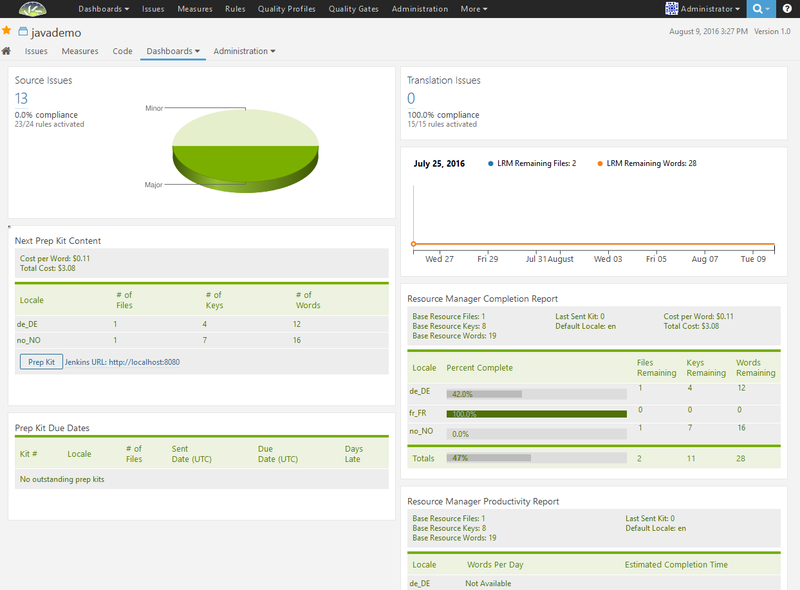Difference between revisions of "About Localyzer"
(→What Does the Lingoport Resource Manager Do?) |
(→What Does the Lingoport Resource Manager Do?) |
||
| Line 39: | Line 39: | ||
* When the corresponding prep kit is received from the localization vendor for a locale, LRM validates the translated files and adds the translated files to the source code repository. |
* When the corresponding prep kit is received from the localization vendor for a locale, LRM validates the translated files and adds the translated files to the source code repository. |
||
| − | The overall process is managed using [[Terms_and_Definitions|Jenkins]]. |
+ | The overall process is managed using [[Terms_and_Definitions|Jenkins]] and jobs developed by Lingoport to automate the process. |
== What Resource File Types are Supported? == |
== What Resource File Types are Supported? == |
||
Revision as of 21:22, 30 May 2017
Contents
Lingoport Resource Manager Overview
Lingoport Resource Manager (LRM) is a software product that bridges the gap between software development and the localization processes. It is geared toward project development organizations tackling globalization of their software so they can target international markets. The Lingoport Dashboard utilizes LRM's report capability to show translation status in a user-friendly display.
- Hand over resource files to translation.
- Process translated files received from translation.
On the project and globalization management side, the Lingoport Dashboard provides an up-to-date status of the resources and their translation by locale. A number of views are presented, with drill-down to the specific issues detected by the Lingoport Resource Manager.
The Dashboard permission settings allows a granular presentation of the Lingoport Resource Manager project so management, development, and/or the translation vendor can all benefit from the status.
This image illustrated the Lingoport Resource Manager (LRM) Dashboard.
- Under Next Prep Kit Content, two locales (de_DE and no_NO - German and Norwegian) each have 1 file to be translated. There are 4 keys to be translated for German and 7 keys to be translated for Norwegian.
- Under Prep Kit Due Dates, it shows that there are no outstanding prep kits to come back from the translation management system.
- The Resource Manager Completion Report says that there is 1 Base Resource Files and it had 8 keys for a total of 19 words. The Default Locale is en (English).
- This project involves three locales: de_DE (German), fr_FR (French) and no_NO (Norwegian). German is 42% completed with 4 keys left to be translated. French is 100% translated and Norwegian is not translated at all.
- The Resource Manager Productivity Report summarizes the Words Per Day for each locale and estimates the Completion Time.
What are the Major Benefits of LRM?
This list capture some of the major benefits of the Lingoport Resource Manager (LRM):
- LRM integrates seamlessly, sending files from repositories to translation and back.
- LRM automates iterative, non-value-added file management tasks.
- LRM automates validation checking for common errors.
- LRM processes reduces human error.
- LRM provides an intuitive, real-time dashboard status overview for all stakeholders.
- LRM supports ease of deployment and operation.
- LRM bridges the gap between development and localization.
- LRM speeds localized resource turnaround time.
- LRM reduces human resource opportunity cost.
- LRM supports industry-standard development environments.
- LRM enhances Agile localization.
What Does the Lingoport Resource Manager Do?
- The Lingoport Resource Manager provides a translation status for resource files.
- LRM facilitates and helps automate passing resource files from the development environment to the translation vendor and back.
- It validates and packages the resources to be sent for translation in a prep kit.
- When the corresponding prep kit is received from the localization vendor for a locale, LRM validates the translated files and adds the translated files to the source code repository.
The overall process is managed using Jenkins and jobs developed by Lingoport to automate the process.
What Resource File Types are Supported?
Lingoport Resource Manager supports the following file types:
- .json (with some restrictions for L10n purposes - See JSON Resource Bundles - Mostly JavaScript, and other programming languages)
- .msg (C, C++, ...)
- .po files
- .properties files (for instance, Java-type resources)
- .resx files (used in the .Net world)
- .rc (Delphi, ...)
- .rjs (for JavaScript)
- .rxml (for xml)
- .strings (Mobile iOS)
- strings.xml (Android)
Does the Resource Manager Compete with Translation Products?
No. Lingoport Resource Manager assists development organizations with automating error prone tasks, as well as managing and tracking resources for global readiness. The Resource Manager is not a translation tool nor is it a content management system (CMS).
Does the Resource Manager Help with Agile Processes?
Absolutely. Lingoport Resource Manager helps automate tasks. It also shows the status of the state of translation within the source code itself. It helps different software development cultures, in particular those applying Agile processes, by facilitating the tracking, sending, and receiving of resource kits. Non Agile processes do still benefit from the Resource Manager.
